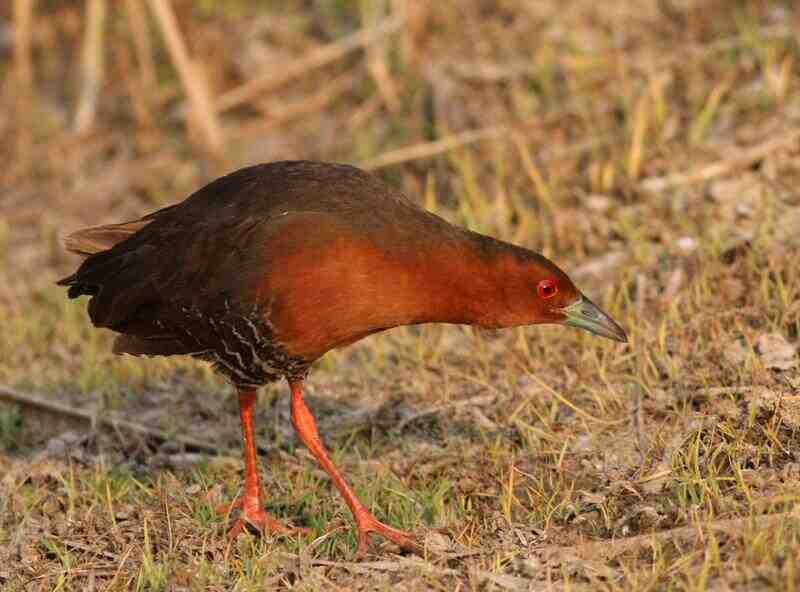Porzana paykullii
IUCN
LCBasic Information
Scientific classification
- name:Porzana paykullii
- Scientific Name:Porzana paykullii,Band-bellied Crake
- Outline:Wading birds
- Family:Gruiformes Railidae Lagomorpha
Vital signs
- length:22-26.5cm
- Weight:110-159g
- lifetime:About 7-10 years
Feature
The upper body is olive brown, the wing coverts have white horizontal stripes, and the front edge of the wings is white when flying.
Distribution and Habitat
Distributed in China, Indonesia, North Korea, South Korea, Malaysia, Thailand and Vietnam. Its breeding grounds are in the Russian Far East and North Korea, and its wintering grounds are in the Malay Peninsula, Sumatra, Java and Kalimantan.
In China, it is distributed in the northeast to the eastern coast, with breeding grounds in Beijing, Hebei, Inner Mongolia (Ikh Zhao League), Liaoning (Dalian), Jilin (Changchun, Jilin, Yanbian, Siping, Hunjiang, Changbai Mountain), Heilongjiang (Yichun, Dailing, Harbin) and Henan provinces, and migrates through Shandong (Qingdao, Yantai), Jiangsu (Yancheng coastal mudflats), Zhejiang, Anhui (Shijiu Lake, Shengjin Lake), Hunan, Hubei (Jianghan Lake Group), Fujian, Jiangxi (Suichuan), Guangdong and Guangxi (Beibu Gulf) provinces.
Spotted-flanked frogs live in lakes, streams, ponds and nearby swamps and grasslands in low mountains and hills and grasslands below 800 meters above sea level. They also appear in sparse forest swamps and forest edge
Appearance
Adult spotted-flanked frogs are similar in both sexes. The forehead is rusty brown, and the feathers on the top of the head, neck, back, waist and tail are all olive brown; the tail feathers are dark brown, and the feather edges are olive brown. The flight feathers are dark brown, the outer vanes of the outermost wing feathers and the outer vanes of the first primary flight feathers are white, the inner flight feathers and wing coverts are olive brown, and there are inconspicuous white proximal spots at the ends of the wing coverts; the inner vanes of the flight feathers of the Guangdong specimen have 5-6 white horizontal stripes, but the outer vanes of the first primary flight feathers are not white, but only 4-5 white spots. The outer vanes of the first primary flight feathers of the other 4 specimens collected from Manjiang, Jilin and other places are all white, but there are no white horizontal stripes on the inner vanes of the flight feathers. The chin and throat are almost white,
Details
Band-bellied Crake, whose foreign name is Band-bellied Crake, is a small wading bird with no subspecies.

Spotted frogs migrate to Northeast China to breed in mid-to-late April in spring, and migrate away from their breeding grounds in late September and early October in autumn.
Spotted frogs often live alone or in small groups. Nocturnal. Mainly active at night and dawn and dusk. During the day they mostly hide in bushes and grass. He is good at walking and can run very fast on the ground, even under dense grass. Generally, they rarely fly. Even if they are frightened in times of crisis, they will not fly very far and fall into the grass or bushes. When flying, the legs hang downward. Very vocal, especially at night. Often a short sound like "urrrr" is made.
Spotted frogs feed on knocking insects, caterpillars, lepidopteran and coleopteran insects and larvae. Also eats snails, mollusks and other small invertebrates and plant fruits and seeds.
The breeding period of spotted frogs is from May to July. Single formulation. Male and female nest in pairs. The nest is usually built in a depression in the ground, in the shape of a shallow plate, placed in a dry place on higher ground, hidden among grass or shrubs, and is generally relatively hidden. The nest is mainly lined with twigs and grass stems, with an outer diameter of 12-14 cm, an inner diameter of 9-12 cm, a nest height of 8-13 cm, and a nest depth of 4-5 cm. Males and females build nests together. Each clutch lays 6-9 eggs, occasionally as many as 10 and as few as 4. The eggs are nearly oval, light earthy brown, with white spots, especially dense at the blunt end. The size of the eggs is 33-36 mm x 26-27 mm. After all the eggs are laid, incubation begins. The male and female parent birds take turns incubating the eggs. The incubation period is 20-21 days.
Since the 1960s, habitats have been destroyed, and swamp wetlands suitable for nesting of this species have been reclaimed as farmland. Tropical rainforests and monsoon forests in the low mountain areas near the Tianba area have been cut down, and economic trees and crops such as rubber have been planted, threatening the species. Frogs lost their habitat. In addition, indiscriminate hunting has caused the number of spotted frogs to decline and is on the verge of extinction.
Listed as endangered species in CITES Appendix II of the Washington Convention.
It is listed as Level 2 in the "List of National Key Protected Wild Animals in China".
Protect wild animals and eliminate wild game.
Maintaining ecological balance is everyone’s responsibility!








